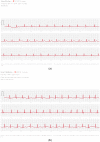Improving Automatic Smartwatch Electrocardiogram Diagnosis of Atrial Fibrillation by Identifying Regularity within Irregularity
- PMID: 38005669
- PMCID: PMC10674836
- DOI: 10.3390/s23229283
Improving Automatic Smartwatch Electrocardiogram Diagnosis of Atrial Fibrillation by Identifying Regularity within Irregularity
Abstract
Smartwatches equipped with automatic atrial fibrillation (AF) detection through electrocardiogram (ECG) recording are increasingly prevalent. We have recently reported the limitations of the Apple Watch (AW) in correctly diagnosing AF. In this study, we aim to apply a data science approach to a large dataset of smartwatch ECGs in order to deliver an improved algorithm. We included 723 patients (579 patients for algorithm development and 144 patients for validation) who underwent ECG recording with an AW and a 12-lead ECG (21% had AF and 24% had no ECG abnormalities). Similar to the existing algorithm, we first screened for AF by detecting irregularities in ventricular intervals. However, as opposed to the existing algorithm, we included all ECGs (not applying quality or heart rate exclusion criteria) but we excluded ECGs in which we identified regular patterns within the irregular rhythms by screening for interval clusters. This "irregularly irregular" approach resulted in a significant improvement in accuracy compared to the existing AW algorithm (sensitivity of 90% versus 83%, specificity of 92% versus 79%, p < 0.01). Identifying regularity within irregular rhythms is an accurate yet inclusive method to detect AF using a smartwatch ECG.
Keywords: Apple Watch; algorithm; atrial fibrillation; electrocardiography; irregularity; mobile health; regularity; smartwatch; wearables.
Conflict of interest statement
The authors declare no conflict of interest.
Figures







Similar articles
-
Can ChatGPT accurately detect atrial fibrillation using smartwatch ECG?Heart Lung. 2025 Sep-Oct;73:90-94. doi: 10.1016/j.hrtlng.2025.04.032. Epub 2025 May 8. Heart Lung. 2025. PMID: 40345017
-
Diagnostic accuracy of apple watch ECG outputs in identifying dysrhythmias: A comparison with 12-Lead ECG in emergency department.Am J Emerg Med. 2024 May;79:25-32. doi: 10.1016/j.ajem.2024.01.046. Epub 2024 Feb 4. Am J Emerg Med. 2024. PMID: 38330880
-
The WATCH AF Trial: SmartWATCHes for Detection of Atrial Fibrillation.JACC Clin Electrophysiol. 2019 Feb;5(2):199-208. doi: 10.1016/j.jacep.2018.10.006. Epub 2018 Nov 28. JACC Clin Electrophysiol. 2019. PMID: 30784691
-
How useful is the smartwatch ECG?Trends Cardiovasc Med. 2020 Oct;30(7):442-448. doi: 10.1016/j.tcm.2019.10.010. Epub 2019 Oct 31. Trends Cardiovasc Med. 2020. PMID: 31706789 Review.
-
Smartwatch: Looking beyond what you see.J Electrocardiol. 2023 Nov-Dec;81:51-59. doi: 10.1016/j.jelectrocard.2023.07.010. Epub 2023 Jul 24. J Electrocardiol. 2023. PMID: 37562224 Review.
Cited by
-
Intelligent Detection Method of Atrial Fibrillation by CEPNCC-BiLSTM Based on Long-Term Photoplethysmography Data.Sensors (Basel). 2024 Aug 14;24(16):5243. doi: 10.3390/s24165243. Sensors (Basel). 2024. PMID: 39204938 Free PMC article.
-
Accuracy and interpretability of smartwatch electrocardiogram for early detection of atrial fibrillation: A systematic review and meta-analysis.J Arrhythm. 2025 May 22;41(3):e70087. doi: 10.1002/joa3.70087. eCollection 2025 Jun. J Arrhythm. 2025. PMID: 40406413 Free PMC article.
-
Comparison of diagnostic accuracy of electrocardiogram-based versus photoplethysmography-based smartwatches for atrial fibrillation detection: A Systematic Review and Meta-Analysis.Ann Med Surg (Lond). 2025 Mar 19;87(4):2307-2323. doi: 10.1097/MS9.0000000000003155. eCollection 2025 Apr. Ann Med Surg (Lond). 2025. PMID: 40212135 Free PMC article.
References
-
- Pappano A., Wier W. Cardiovascular Physiology. 11th ed. Elsevier Health Sciences; Philadelphia, PA, USA: 2018.
-
- NHS Atrial Fibrillation—Treatment—NHS. [(accessed on 4 May 2023)]. Available online: https://www.nhs.uk/conditions/atrial-fibrillation/treatment/
MeSH terms
Grants and funding
LinkOut - more resources
Full Text Sources
Medical

